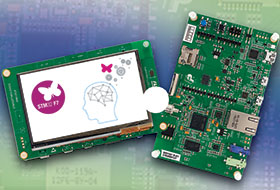

STMicroelectronics pronounced itself the winner of the race to commence volume production of microcontrollers (MCU) featuring the ARM Cortex-M7 processor.
Optimised for advanced consumer, industrial, medical and Internet-of-Things (IoT) devices, this latest and highest-performing Cortex-M core is harnessed by the company’s new STM32F7 family.
The Cortex-M7 core has roughly twice the digital signal processing (DSP) capability of the Cortex-M4 core – ideal for applications requiring high-speed or multi-channel audio, video, wireless, motion recognition or motor control. It is also the first Cortex-M core to feature on-chip cache, and is capable of ultra-fast data transfers and high-performance execution from embedded Flash or from external memories such as dual-mode Quad-SPI (QSPI).
Features integrated by ST include a dedicated power rail for the USB OTG peripheral, which enables USB connectivity to continue operating while the rest of the chip is powered at 1,8 V to save power. The dual clock domain on most peripherals allows the CPU speed to be reduced to minimise power consumption, while keeping the clock frequency unchanged on the communication peripherals.
The new devices comprise the STM32F745, STM32F746 and STM32F756 families. The STM32F745 has up to 1 MB of Flash memory on-chip, as well as 320 KB RAM, Ethernet, QSPI and camera interfaces, and a flexible memory controller (FMC). The STM32F746 extends this functionality with an onboard TFT-LCD controller. The STM32F756 extends this feature set further to include a crypto/hash processor providing hardware acceleration for AES-128/-192/-256, with support for GCM and CCM, Triple DES and hash (MD5, SHA-1 and SHA-2).
Running at up to 216 MHz, the devices deliver processing efficiency up to 6 CoreMark/mW at 1,8 V, typically consuming 100 μA in stop mode with all SRAM saved. This power efficiency is achieved through ST’s 90 nm chip fabrication process, unique ART Accelerator graphic engine that reduces Flash access time, and advanced voltage scaling and underdrive/overdrive that help optimise speed and power consumption.
The STM32F7 devices are available in a range of package options from a 14 x 14 mm LQFP100 to 28 x 28 mm LQFP208, plus 10 x 10 mm (0,65 mm pitch) UFBGA176, 13 x 13 mm (0,8 mm pitch) TFBGA216, and 5,9 x 4,6 mm WLCSP143. It is also possible for developers to re-use all STM32F4 software assets thanks to code compatibility with STM32F7.
Complementing and easing implementation with the new MCUs across a diversity of applications, the STM32F7 Discovery Kit comes with the comprehensive STM32Cube firmware library, as well as direct support from a wide ecosystem of software development tool partners and the ARM mbed online community.
The kit’s open hardware exposes the STM32F7 assets through an affordable, compact design including WQVGA touchscreen colour display, stereo audio, multi-sensor support, security and high-speed connectivity. Together with an integrated ST-Link debugger/programmer, expansion capability is provided through Arduino Uno connectivity support and immediate access to a large choice of specialised add-on boards.
For more information contact Arnold Perumal, Avnet South Africa, +27 (0)11 319 8600, [email protected], www.avnet.co.za

© Technews Publishing (Pty) Ltd | All Rights Reserved